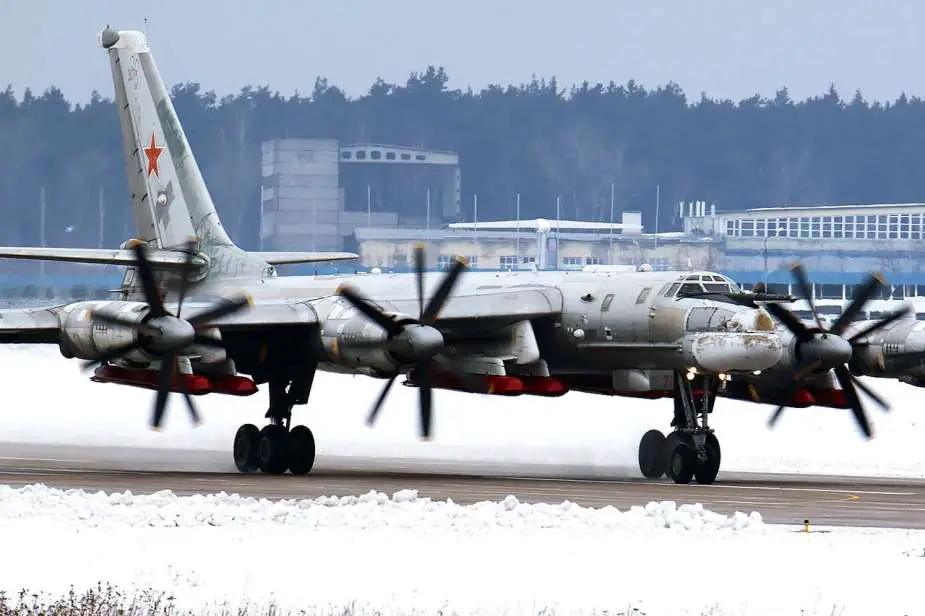- Army
- Conflicts in the world
- Israel - Iran conflict 2025
- Pakistan - India Conflict 2025
- Russia Ukraine War 2022
- Libya conflict day by day
- HAMAS - Israel War 2023
- Operation Serval in Mali French Army
- Sangaris operation Central African Republic
- Sangaris opération militaire République Centreafrique
- Ukraine - Russia conflict
- Syria conflict news
- Defence & Security Industry Technology
- Armies in the world
- Analysis Defense and Security Industry
- Conflicts in the world
- Navy
- Air
British Intel Announces Russia's First Major Missiles Attacks on Ukraine in Over a Month
In a significant escalation of hostilities, Russia launched a major Long Range Aviation (LRA) strike against Ukraine on March 21, 2024, marking the first such attack in over a month. The British Ministry of Defense (MoD) Intelligence reported that the offensive involved at least 10 Tu-95 BEAR-H aircraft and support from MiG-31 FOXHOUND fighters launching Kh-101 cruise missiles and Kh-47M2 Kinzhal ballistic missiles, originating from the Olenegorsk and Engels airbases.
Follow Army Recognition on Google News at this link

Russian Tu-95 strategic bomber armed with Kh-101 cruise missiles. (Picture source Russian MoD)
The strike force conducted by Russian aircraft unleashed at least 20 missiles, including the advanced AS-23A KODIAK air-launched cruise missile, Russian designation Kh-101, and the AS-24 KILLJOY air-launched ballistic missile, Russian designation Kh-47M2 Kinzhal, with Kyiv being the primary target. This operation ended a 44-day hiatus in aviation strikes on the Ukrainian capital.
The Army Recognition Editorial Team, referencing information from the British Ministry of Defense (MoD), reported on a major Russian airstrike that took place during the night of December 7, 2023, aimed at Kyiv and central areas of Ukraine. This attack was noteworthy for reintroducing the use of Tu-95 BEAR H heavy bombers in such assaults for the first time since September 21, 2023. These bombers were utilized to discharge a volley of cruise missiles, particularly the Kh-101, which is also recognized by its NATO designation AS-23A KODIAK. The operation saw the launch of at least 16 Air-Launched Cruise Missiles (ALCMs) from the vicinity of the Caspian Sea, an area from which these aircraft commonly operate.
The AS-23A KODIAK, Russian designation Kh-101, is a sophisticated air-launched cruise missile developed by Russia, designed for long-range precision strikes. It operates as a strategic weapon capable of being launched from heavy bombers such as the Tu-95 BEAR H, allowing for deep penetration into enemy territory without risking the aircraft. This missile is known for its stealth capabilities, high accuracy, and the ability to carry a conventional or nuclear warhead, making it a versatile weapon in modern aerial warfare.
The AS-24 KILLJOY, known in Russian military nomenclature as the Kh-47M2 Kinzhal, is a cutting-edge air-launched ballistic missile designed for precision strike missions. Distinguished by its ballistic trajectory and rapid approach, the Kh-47M2 Kinzhal stands out for its difficulty to intercept, making it a formidable weapon in penetrating adversary defenses. Launched from aircraft, it targets high-value, fortified, or urgent targets deep within enemy lines with exceptional accuracy. Capable of being armed with either conventional or nuclear warheads, the Kinzhal offers versatility in addressing various tactical needs.
The Kh-47M2 Kinzhal (AS-24 KILLJOY) and the Kh-101 (AS-23A KODIAK) missiles represent two pillars of Russia's strategic long-range precision strike capabilities, offering distinct yet complementary avenues for destruction and combat effectiveness. The Kh-47M2 Kinzhal, with its hypersonic speed and ballistic trajectory, specializes in penetrating deeply entrenched defenses and delivering rapid, high-impact strikes against critical infrastructure, carrier groups, or high-value targets, significantly complicating interception efforts. On the other hand, the Kh-101, a stealthy air-launched cruise missile, excels in its ability to fly extended distances at low altitudes, evading radar detection to ensure precision strikes on strategic assets with minimal collateral damage. Together, these missiles provide a versatile and formidable offensive capability, capable of challenging and overcoming modern air defense systems, thus enhancing strategic deterrence and operational flexibility in conflict scenarios.
The British MoD suggests that the break in LRA (Long Range Aviation) strikes may have been influenced by logistical challenges within the Russian military apparatus, notably in aircraft fleet management and planning. International sanctions have severely limited Russia's access to essential components for both its aircraft and missile systems. Additionally, the consistent efficacy of Ukrainian air defenses has posed significant hurdles to Russian strategic operations, potentially complicating mission planning efforts.
Despite these challenges, Russia seems poised to continue its strategic bombing campaign. The British MoD assesses that Russia aims to keep up the pressure on the Ukrainian government and its civilian populace by leveraging its stand-off strike capabilities. This strategy indicates a persistence in the use of tactical air power, such as fighter jets and helicopters, which thus far has had a limited effect on the overarching conflict dynamics.
The continuation of these strikes underscores the prolonged nature of the campaign against Ukraine, with Russia seemingly committed to utilizing its available military assets to exert pressure. The international community watches closely as the situation unfolds, with concerns over the potential escalation and further civilian casualties.
Defense News March 2024


























